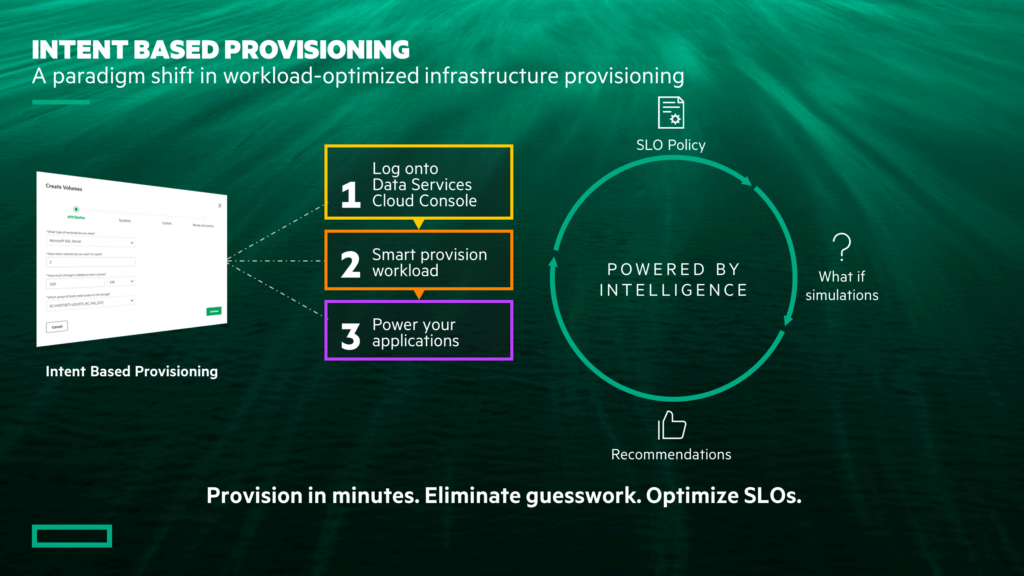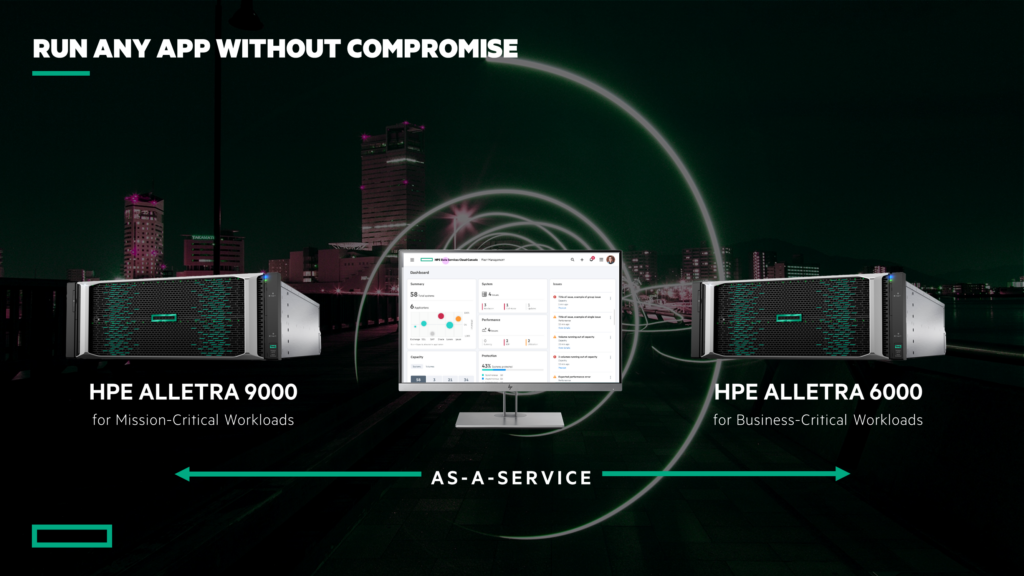[vc_row][vc_column][vc_column_text] On May 4th, HPE Storage made a massive announcement. Leading up to it, I had a blog post with a video that talked about it being the biggest thing I’ve worked on in my 30+ years in HPE Storage. It’s true. There’s a shift that I think is happening in the industry and that big – dare I say seismic? – shift is reflected in the announcement.
On May 4th, HPE Storage made a massive announcement. Leading up to it, I had a blog post with a video that talked about it being the biggest thing I’ve worked on in my 30+ years in HPE Storage. It’s true. There’s a shift that I think is happening in the industry and that big – dare I say seismic? – shift is reflected in the announcement.

Here’s a dialog I had with Tom Black, the SVP and General Manager of HPE Storage. I’ll also insert a few Chalk Talks to give you a bit more on some of the big elements we talked about.
What is Unified DataOps?
Calvin Zito: You made some very bold statements in our May 4th announcement about how HPE is changing storage and data management forever. How are you going to do that?
Tom Black: We have a new vision that we are calling Unified DataOps. Unified DataOps embodies are our new true north for this business: bringing a cloud operational model to our customers from a data services-centric perspective, wherever their gear is – on-premises or in a co-lo. The net benefit of this very bold new offer is, we’re going to help people accelerate their digital transformation and in a very data-driven, highly contextual manner.
Calvin: Let’s talk more about the vision of Unified DataOps. What does it look like?
Tom: It’s about bringing a new data-services platform to our customers, allowing them to reduce complexity, allowing them to run their estate in a more agile cloud-native manner. We’re really transforming our business into a cloud-first, software-defined model.
Check out my Chalk Talk on Unified DataOps that gives an overview of this paradigm shift and introduces a couple of new products that are key to how it will all be delivered.
Let’s talk about what is new
Calvin: So we announced some new products and services on May 4th, let’s talk about those.
Tom: There are two components that we announced on May 4th.
- First is the Data Services Cloud Console. This is the landing zone, where customers can visualize, provision, and manage their data, and access a host of other value-added services. It also includes our award-winning AIOps, powered by InfoSight.
- The second very exciting part of what we announced is a new brand of data infrastructure products: HPE Alletra. For mission-critical high-end workloads, we introducied the HPE Alletra 9000, and for business-critical workloads we announced the HPE Alletra 6000.
Why is this so exciting? Let’s look at it from a customer-in perspective. Typically, installing sophisticated storage equipment was a bit arcane. It was a very complicated process; these were huge IT projects. Our May 4th announcement changes all that. With this new approach, you roll the kit into the data center, rack it up, plug it into the network, plug it into power, and a couple of clicks later your equipment shows up in your console. You can manage it from anywhere in the world, and it’s super easy.
Storage technologies had been siloed and used for very specific workloads, and customers had to keep that in mind. We’ve added something called intent-based provisioning that takes the burden off the customer. You go into your Data Services Cloud Console and it understands the fleet of equipment you have in your estate. You simply express the workload you want to run and the system finds the right place to put the workload based on capacity and performance, making it very simple for customers to use. We do all the work with our algorithms and our AI so you don’t have to.

Let’s dive deeper into Data Services Cloud Console
Check out this short demo of Data Services Cloud Console and also my Data Services Cloud Console Chalk Talk.
Calvin: Let’s talk more about Data Services Cloud Console. Is this just another device management application or is there more to it than that?
Tom: There is way more to it (my engineers would gasp if they heard that!). We started the journey of building a SaaS platform many years ago in Aruba and now we’re able to leverage that core platform technology to bring out Data Services Cloud Console. We’re talking about a platform that is mature and has been in the market for a long time with millions of devices under management. And now we are able to put our storage and data services on top of that platform. What’s really unique about the Data Services Cloud Console is that it abstracts away different storage technologies and lets customers focus on their data and their applications – and how their applications use data.
This new cloud console homogenizes the visibility, the analytics, and the provisioning of storage resources from that application- and data-centric point of view. This isn’t simply a newfangled place to run management software – it’s a fundamental pivot from storage to data and data services.
Calvin: You’ve touched on cloud agility, give me an example of how you are changing things for customers in this new environment?
Tom: In a classic on-premises or colo, if you wanted to stand up a new application, you’re going to file a series of requests with IT. Those requests would be broken down into work orders for different functional teams. That process could take days or weeks depending on the company and the complexity. One of the things that the public cloud got right is that they made it very easy for someone who wanted to instantiate an application, a workload, or a storage volume. It’s a handful of clicks and you can get it done. What we have done is brought that same cloud operational model, for the first time in the industry, to on-premises or colo equipment. What this means is that the speed and agility you get in a public cloud model you can now achieve inside your own data center, inside your own facility. So instead of that complex series of workflows, you can allow an end user, a developer, to instantiate services or a volume and understand how the data is being managed through its lifecycle. And that is a complete flip from complexity to simplicity.
Calvin: By taking the conventional storage experience to a cloud model you’re introducing other considerations like security. Will customers worry about the additional risk?
Tom: That’s a fair point. Although I have to say, I talk to large and small customers all the time, and I can’t remember the last time I talked to somebody who didn’t have a cloud agenda. They are already using cloud. But that doesn’t diminish the security factor. Specific to this technology stack, we paid a tremendous amount of attention to security both on our software and where it runs, but more importantly we actually allow the enterprise to have an enhanced security posture. Customers can keep a very hard perimeter on their firewall because the HPE Alletra systems dial out in a highly secure, authenticated, and encrypted manner to Data Services Cloud Console. You don’t need to bring a support person on site to your data center. You don’t need to let somebody VPN in to troubleshoot something. It’s very safe and very secure. Security is designed into the flow of how you manage things day to day.
Now let’s look closer at HPE Alletra
Here’s my HPE Alletra Chalk Talk that is good visual overview.
Calvin: Tom, tell me more about HPE Alletra and how it relates to Data Services Cloud Console?
Tom: Delivering the cloud operational model requires cloud native infrastructure. HPE Alletra is our cloud native infrastructure, specifically designed to work in concert with the cloud. The software on the system that’s on-premises needs to coexist in a very symbiotic closed-loop manner with the software that runs on the Data Services Cloud Console. HPE Alletra has been designed to meet all the criteria for cloud native. It will be our brand for all things cloud native moving forward in our storage business, everything powered by the Data Services Cloud Console. Together, they provide the ability to visualize, provision and get deep insights on your data from edge to the cloud with that operational experience that people really are yearning for – the kind of simplicity that makes workloads and app scaling as simple as flipping a switch.
Calvin: Speak to the customer reading this now – what does this announcement mean from their perspective?
Tom: Here is what it means for them:
- For IT, the cloud operational model means they can move faster and be more productive. They can get time back to spend on strategy and projects versus having to do rote tasks again and again and again.
- For a line of business, this new experience really means their data infrastructure can be self-provisioned like you would see in the public cloud, right? So instead of having to go through all the typical IT workflows, the end user can actually go ahead and provision a data service on their own through a role on the console.
- For data innovators, whether it’s DBAs or developers or analysts, they now have the ability to consume infrastructure and, ultimately, data as code.
For all customers who experience this new technology, we deliver even greater value, including seamless data protection and managing business and compliance risk as we bring this operational model into this unified data services-first approach.
Wrapping it up with closing thoughts
Calvin: Skeptics will say the storage industry hasn’t changed much in the last two decades. How and why is HPE able to bring to market this new innovation when so many others couldn’t do this?
Tom: There are a few factors:
- At HPE, we have a deep, deep rich DNA in innovation, engineering and technology. Our current CEO, Antonio Neri, is truly a bold innovator, very focused on the customer in the market, who really encourages his team to focus and deliver where there’s opportunity. We have a culture of risk-taking in innovation.
- The second factor is that really deep technology well. We didn’t start this project from zero. We have vast amounts of intellectual property, lots of fantastic shipping products. This innovation is about adding the new features and experiences our customers need on top of what we had and bringing it to market in a very focused way.
- Third – and this is the most humbling and exciting part of this announcement – is the team I work with. It takes a certain fortitude to do something this big, this different, and really do it as fast as we did. There are some Monday mornings you wake up, and you’re a little afraid of the week, and there are some Friday nights you go to bed and say, “I’m not sure if I won this week or not.” And there’s always that belief in doing the right thing for the customer. It’s the relentless grit to overcome the obstacles that inevitably show up in something this big. That’s what it takes to get it to market.
Calvin: What does it mean to you personally?
Tom: The greatest joy is watching really talented people accomplish something really difficult during a very challenging time. It’s these things you remember for the rest of your career. And I’m super-excited for my customers because – I’ve done dozens and dozens of briefings now, for this launch – and you could just see the light go on their eyes when they realize they’re getting a simplified, deeply valuable, cloud operational experience applied to the gear they have on-premises. This is a first. It lets them bring agility to their organization in a whole new way, and it also helps reduce cost. This is going to change their cost profile, change their speed, their agility, their ability to get to their business outcomes without some of the baggage of yesteryear.
So, all in all, I am just super-excited to bring this to market.
Calvin: How does this new platform fit into HPE’s overall strategy? What’s the big picture here?
Tom: I’m going to go back and talk about the promise Antonio made to the market when he said, “We are going to be the edge-to-cloud Platform-as-a-Service company, and everything in our business will be available as-a-service by 2022.” Today marks another major milestone in delivering on that promise. In my organization, we call it the “do/say ratio”. This is a very high “do” versus “say.”
And, of course, this expands our HPE GreenLake brand. So now GreenLake can include very sophisticated, highly automated storage services as part of our as-a-service offer.
Calvin: Tom, thanks for your time and great job by you and the team!
Tom: Thanks a lot, happy to help our customers understand this bold strategy we have announced.
As always, you can find our Around the Storage Block blog at hpe.com/storage/blog. There are a number of articles related to the May 4th announcement that you will find on our blog. You can find me on Twitter as @CalvinZito and feel free to find me on LinkedIn – but be sure to tell me you are a Connect member.[/vc_column_text][vc_column_text]
[/vc_column_text][vc_empty_space][/vc_column][/vc_row]




